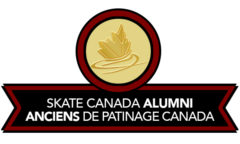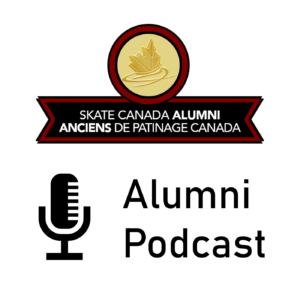
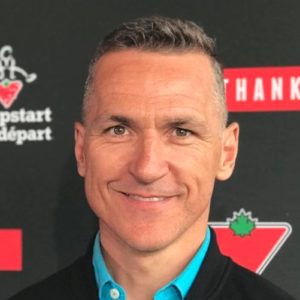
As Athlete Ambassador of the 2019 Canadian Tire National Skating Championships, Elvis shared accounts of some of his experiences competing at Nationals, the things it taught him and the lessons he hopes he can pass along. 20 years post competition and he is still one of the most sought-after performers in the world. Listen Now »
![]()
About the OLY Designation?
By Denise Benning, OLY
When you see the letters PhD after someone’s name, it is recognition that the individual has reached the highest academic level, an accomplishment which took years of hard work and sacrifice to achieve. From a sports perspective, this description also rings true when considering the dedication it takes to compete as a high-performance athlete.
This resonated with the World Olympians Association (WOA) who believed that athletes deserved a similar designation to recognize their achievement of competing at the Olympic Games. As WOA President, Joel Bouzou said, “Much like a doctor, a lawyer or a university professor, becoming an Olympian takes many years of hard work and requires a diverse range of skills. I believe this initiative will provide Olympians with the professional recognition they deserve.”
The OLY designation was launched in November 2017 and since then thousands of Olympians have registered for the initiative available to anyone who has competed at a Summer or Winter Olympic Games. Once registered, you receive a certificate from the WOA and the right to use the letters anywhere you use your name, such as on official documentation, resumes and social media. According to the WOA, “OLY provides a symbolic recognition of an Olympian’s status in society, promoting an Olympian’s social, charitable, and community-based work and acting as a reminder of their achievements and of their responsibility to embody the values of Olympism in everyday life.”
I registered for my designation shortly after the program launched. It was rewarding to receive the certificate as recognition of my achievement but I wasn’t quite sure how I was going to use the OLY letters. However, over the past year, I have started to understand the value of it as a professional tool.
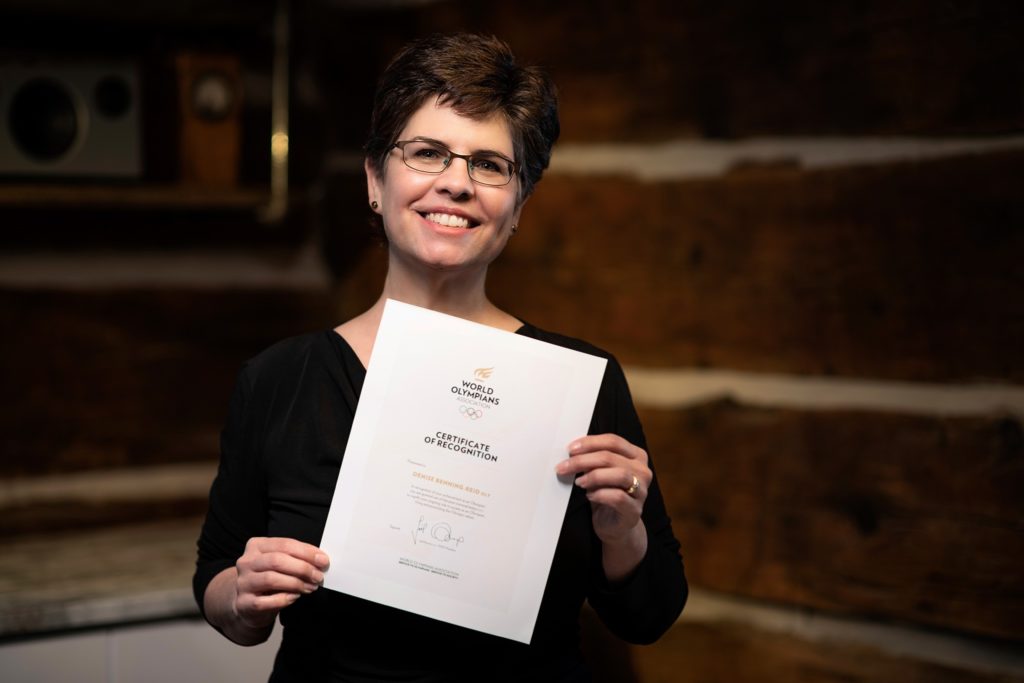
Having competed at the Calgary Games 30 years ago, I sometimes struggle with how best to include my identity as an Olympian into my current professional identity. I have found that by adding OLY after my name at the top of my CV, LinkedIn account and business cards, it’s an effective way to let people know I am an Olympian plus it can be a great conversation starter with business connections. It has also connected me to the Olympian community. Now when I browse LinkedIn or other social networks, it’s easy to find other Olympians through their OLY designation and I realize once again what an honour and privilege it is to be part of this Olympic family.
If you are interested in applying, you can do so at: https://olympians.org/olympians/oly/
![]()
The Whistle
By Nancy Sorensen
Golf isn’t the only sport with caddies. Figure skating has had its caddies too. Before electronic scoring, caddies (usually teenage skaters of the host club) sat behind the judges with boxes containing numbers. After every performance, judges communicated their marks to their own caddy, one per judge. At the referee’s whistle, the caddies displayed these marks. Accountants, sitting across the arena, recorded the numbers for processing in the accounting room.
Being a caddy was special. You had one of the best seats in the house, a responsible job, sometimes a special uniform, and you were very visible. Caddies trained ahead of time: standing nice and straight, holding marks at eye level, smoothly getting the number cards in/out of the boxes, putting them back in correct numerical order and performing these duties to whistle signals from the event referee. However, practising in an empty arena was quite different from being the centre of attention in a crowded ice facility with announcers, television cameras, media people, blazing lights and judges sitting right below you.
At a Western Divisionals, a qualifier for Canadians, we had a dance referee, experienced, knowledgeable, efficient, and well respected. He was also noted for being fussy and rather demanding. Judges were usually aware of his reputation and would, at times, feel uneasy being on his panel.
The compulsory dances were to begin, and the referee snapped his orders to judges and caddies. One caddy, unnerved by the situation, was, initially, a bit slow getting her marks out of her box. She dropped a number, and a couple of times, started to lower her marks slightly before the whistle. An irritated referee, in front of the crowd, barked at the girls, reminding them that the display of marks coincided with his whistle.
After a dance performance, the referee stood up, blew his whistle, marks came up, announcer read the scores. Perfect! He waved to bring on the next competitors. The announcer gestured and pointed. The ice captain across the ice did the same. Nothing was happening! A few more gesticulations indicated something was amiss behind him. He turned to see the caddies, ramrod straight, like soldiers on inspection, bravely holding up the scores. He had neglected to blow his whistle! A few arm waves to prompt the caddies to lower their numbers didn’t work. Only a whistle would do.
An easy fix. But where was the whistle? A quiet audience watched while he searched. It wasn’t in his hand or on his table. Shuffling his papers unearthed no whistle. Had it fallen on the floor of the judges stand? Shifting the table legs was unproductive. His pockets yielded nothing. Then he glanced down and there it was, on the seat of his chair. Whistle retrieved, the referee blew his signal, the caddies responded. For the rest of the event both referee and caddies performed their duties perfectly.
One couldn’t help but chuckle at this brief drama. The caddies commanded some admiration for taking a stand and just following orders.
![]()
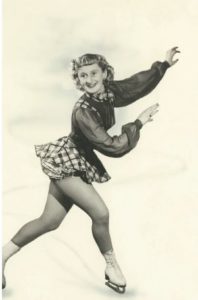 Meet the incomparable Jean Westwood, competitor, World Champion, Coach, Choreographer, dog breeder and judge, guru and trend setter. At 87 years young, Jean is as feisty and forthright today as she was when she and partner Lawrence Demmy took the dance world by storm over 60 years ago!
Meet the incomparable Jean Westwood, competitor, World Champion, Coach, Choreographer, dog breeder and judge, guru and trend setter. At 87 years young, Jean is as feisty and forthright today as she was when she and partner Lawrence Demmy took the dance world by storm over 60 years ago!
In this edition of the Alumni Blog, meet Jean Westwood as we feature Part 1 of Jean’s Gems.
JEAN’S GEMS – Part 1
MY BELIEFS
There are no dumb champions. Education is vital for learning essential quick reaction.
I successfully competed in all 3 disciplines which set me up to coach successfully in each one, singles, pairs and dance, with success in them all.
Champions are born not made. A top coach may help students to achieve goals earlier while a coach of lesser talent may inadvertently prevent a student’s success.
A good coach puts their pupils’ wishes ahead of their own ambitions, i.e. attending National and International Events.
A true champion will eventually make it regardless.
I am a strong believer in Fate and Destiny for competitors and coaches: the destiny of being in the right place at the right time with the right pupil or adversary.
I hold myself more fortunate than most future coaches due to ALL the coaches I was privileged to learn from.
MY ACCOLADES
British and European Dance Champion 1954 & 1955
International Dance Champion 1951 (lead-up event to World Dance Championship)
World Dance Champion 1952-1953-1954-1955
Canadian, USFSA and World Hall of Fame
Presented to HRH Queen Elizabeth 2nd (and curtsied without falling down)
British Junior Pairs Champion and North of England Singles Champion.@1952
MY HISTORY
BORN NOV 1ST, 1931 in MANCHESTER, ENGLAND
Scottish Parents (entire family Scottish)
Father – Medical/Dental Doctor; Grandfather – Presbyterian Minister
I started skating at the age of 6 under duress as my sister wanted to skate. As a result I had to give up my involvement with horses.
I was fortunate in my individual coach experiences as they all believed my talent was beyond their capabilities and forwarded me on to a more senior coach. Either that, or I was too troublesome to control!
- Coach #1- Peri Livitsky, I believe was Czech. I became the Mascot of the Hockey Team to bring the puck out on to the ice. I admit, I was a “Brat”, spoiled by all. Ms. Levitsky handed me over to Senior Coach, Ellen Dallerup from Denmark, understood to be the first skater to do a One Foot Spin!
- I rapidly progressed and the Senior Area Judge, Ethel Muckelt, who competed in Olympics with Jack Page, judged all my tests and was actively interested in my progress. Ethel was my first mentor and judged most of my British tests -singles/pairs & dance.
- Brother and sister, Phil and Megan Taylor, also trained in Manchester. Phil was killed in the war but Megan along with Cecelia Colledge dominated the World Championships from 1937 to 1939. Manchester Ice Palace was closed to skating during the war years and used for airplane repairs. I was fortunate to meet and watch both Megan and Cecelia and met them both later when I was coaching in the U.S.
- At 8 years of age I gladly gave up skating and went back to horses. Occasionally a group of us went to Blackpool for the day to skate. I went back to skating after the war but my sister Ann was much more dedicated than me winning all the single events with Muriel Kay Fulton second and yours truly third. Quite happily — my competitive streak came later.
- Muriel Kay was chosen by Reginald Wilkie to exhibit ice-dancing across Europe. Mr. Wilkie (formerly partnered with Daphne Willis) invented the Paso Doble, Quickstep and Argentine Tango. British Dance Champion 1936/37/39. He was my second mentor.
- War was eventually over with many bad memories best forgotten. Skating resumed and Ann and I started ice-dancing as well as skating singles. My sister became the youngest Silver Dance Medalist (at 12 yrs old) at that time. She had much more talent than me.
- When I was 14 and my sister 17, we were sent to Cheltenham Ladies College (lost cause for me!) My sister tragically died that summer after accidentally being given a drug overdose by a doctor.
- I returned to skating in the holidays when Ellen Dallerup transferred me to Jack Wake, the Rink Manager.
THE ROAD TO BECOMING 4-TIME WORLD CHAMPIONS
- By 1950 most nations at this time held their Nationals AFTER Worlds and then selected their next year’s World Team. In England all their couples had retired, split up or turned professional. It was decided to hold a trial and select a team to enter the International Dance Competition, the forerunner of the World Dance Championship, in Milan during the World Figure Skating Championships.
- In October I was involved in a serious car accident while attending Liverpool University and was hospitalized for a month, then following up with physiotherapy. By that time I’d formed a new partnership with Lawrence Demmy. We decided to enter the aforementioned trials.
- The event was not actually “judged”, but 2 couples were selected – me and Lawrence and John Slater (my previous partner!) and Joan Dewhirst. So off we went to Milan where Lawrence and I won the first competition we entered, which just happened to be the equivalent of a World Championship. Some way to start a career! Returning to England we did not win the National Title, nor did we win for the next 2 years even as reigning World Champions.
- Everything changed in 1954 when we were crowned British, European and World Champions, first holders of the official World Title in 1952 and the European Title in 1954.
- We also started dance instruction from Len Liggett in Liverpool. He and Mr. Wilkie were both wonderful dancers with soft, syncopated knees. Mr. Liggett partnered me through my dance tests stating Lawrence “was not good enough”. Of course, as world champion, Lawrence was NOT impressed.
- Jack Wake, the arena manager, did an extraordinary thing. He explained to my parents that my talent was such that it deserved coaching from a top level coach in London. I was to select the coach from 3 names then explain to him the reason for my choice. I was only to observe their methods. I chose Dame Gladys Hogg since it appeared to me that she taught all students in their own style.
- At this time I was on my gold figure test. Len Liggett joined an Ice Show in 1953 so it was natural that we asked Miss Hogg to also train us in dance.
- Jack Wake taught me to place the future of the pupil ahead of my own interests.
- Mr. Liggett taught me syncopated rhythm and soft knees like Reg Wilkie.
- Dame Gladys Hogg taught me to teach myself and do the choreography for the pair, an important skill for the future.
- This also taught me choreography to give my students. (Nowadays coaches also have a choreographer/trainer, etc.) That is the reason so many of her pupils became top International Coaches in North America as she trained us to do it all. I even did embroidery on my students’ costumes!
- Being a qualified Occupational Therapist added to my coaching skills.
- Some of Gladys’ previous students became top coaches: John Nicks, Doreen Denny, myself and others such as Bernie Ford, Joan Dewhirst Slater, to name a few.

![]()
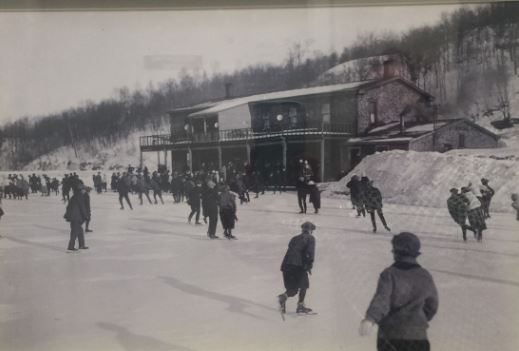
In 1833, British officers in New Brunswick brought the concept of skating club from Scotland to Canada and founded a club centering on the Natural ice of Lily Lake near Saint John, NB. The first skating club in Canada opened in 1833 on Lily lake , Saint John, New Brunswick
![]()
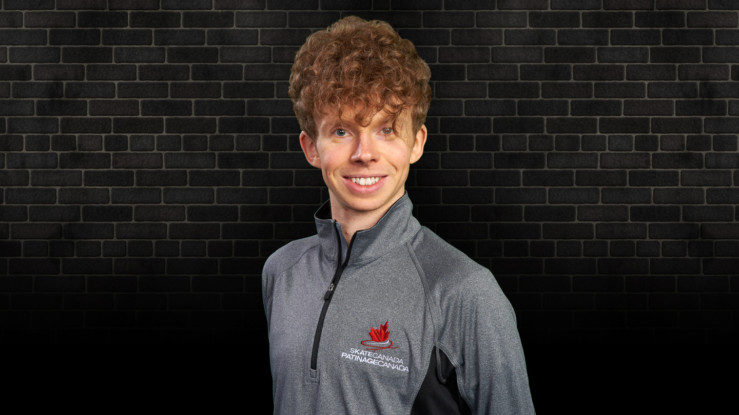
Olympic Silver Medallist Kevin Reynolds Retires from Competitive Skating
Olympic silver medallist and six-time national medallist Kevin Reynolds, 28, Coquitlam, B.C., has announced his retirement from competitive skating. Reynolds has been a constant on the skating scene since 2002, when he won the Canadian novice title. He won a silver medal as a member of the Canadian squad in the team event at the 2014 Olympic Winter Games in Sochi, Russia.
“Despite an encouraging start to the season with a new personal best short program, I was unable maintain this form and my body has started to tell me it has had enough. It was a tough decision but given the circumstances I know it is the right choice,” said Reynolds.
Reynolds continued, “I would like to thank Skate Canada for their support throughout my long and wonderfully rewarding competitive career. I would also like to thank the many Canadian and Japanese skating fans who always supported and believed in me, even in those moments where I doubted myself. Finally, I would like to give a special thank you to my long-time coach, Joanne McLeod, who has been with me on this incredible journey every step of the way. I look forward to continuing my involvement with the sport of skating as I move on to the next phase of my life and pursue new career opportunities.”
Reynolds is an eight-time senior national team member and has represented Canada at the world championships six times. In 2013, he won his first senior gold medal on the international circuit at the ISU Four Continents Championships. During his successful junior years, he qualified for the 2006 ISU Grand Prix Final, wining the bronze medal.
“Kevin has been an important part of our national team program for the last decade. We would like to thank him for his dedication to the sport and for his innovative style of skating combined with his technical skill that inspired so many around the world,” said Debra Armstrong, CEO, Skate Canada. “Skate Canada wishes Kevin all the best as he begins a new chapter of his life.”
Reynolds helped to move the sport forward with his advanced jumping skills. In 2010, he was the first skater to land two quad jumps in a short program. He was also the first skater to land five quad jumps in competition at the 2013 ISU Four Continents Championships, with two quads in the short program and three in the free program.
Reynolds is working towards completion of his degree at the University of British Columbia. He is expected to graduate in 2019 with a Bachelor of Arts in International Relations, with a minor in Japanese Language and Culture. He will be staying involved with skating as a full-time coach at the Champs International Skating Centre of B.C.
![]()
We’d love to hear from you! Today staying in touch is easier than ever!
E-mail us your stories, photos, thoughts, suggestions and questions. We can’t guarantee we’ll print each one however we will certainly read every word and in the case of questions, find answers to them all.
Contact Celina Stipanic, Alumni and Fund Development Manager at [email protected]
